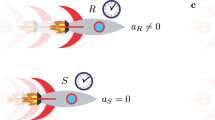Abstract
The gedanken experiment of the clock paradox is solved exactly using the general relativistic equations for a static homogeneous gravitational field. We demonstrate that the general and special relativistic clock paradox solutions are identical and in particular that they are identical for finite acceleration. Practical expressions are obtained for proper time and coordinate time by using the destination distance as the key observable parameter. This solution provides a formal demonstration of the identity between the special and general relativistic clock paradox with finite acceleration and where proper time is assumed to be the same in both formalisms. By solving the equations of motion for a freely falling clock in a static homogeneous field elapsed times are calculated for realistic journeys to the stars.
Similar content being viewed by others
References
1. C. W. Misner, K. S. Thorne, and J. A. Wheeler, Gravitation (Freeman, San Francisco, 1973), pp. 163–174.
2. C. Moller, The Theory of Relativity (Claredon, Oxford, 1955).
3. L. Iorio, “An analytical treatment of the clock paradox in the framework of the special and general theories of relativity,” Found. Phys. Lett. 18, 1–19 (2005).
4. A. Einstein, “On the influence of gravitation on the propagation of light,” Ann. Phys. (Leipzig) 35, 898 (1911).
5. A. Einstein, “On the relativity principle and the conclusions drawn from it,” Jahrbuch der Radioaktivität und Electronik 4, 411–462 (1907) and The Collected Papers of Albert Einstein 2 (Princeton University Press, Princeton, New Jersey, 1989), Anna Beck, translator, pp. 252–307.
6. S. Weinberg, Gravitation and Cosmology (Wiley, New York, 1972).
7. F. Rohrlich, “The principle of equivalence,” Ann. Phys. (New York) 22, 169–191 (1963).
8. D. Tilbrook, “General coordinatisations of the flat space-time of constant proper-acceleration,” Australian J. Phys. 50, 851–868 (1997).
9. H. Lass, “Accelerating frames of reference and the clock paradox,” Am. J. Phys. 31, 274–276 (1963).
10. W. Rindler, “Kruskal space and homogeneously accelerated frame,” Am. J. Phys. 34, 1174–1178 (1966).
11. E. Desloge, “Nonequivalence of a uniform accelerating frame and a frame at rest in a uniform gravitational field,” Am. J. Phys. 57, 1121–1125 (1989).
Author information
Authors and Affiliations
Corresponding authors
Additional information
1 Both authors contributed equally to this paper.
Rights and permissions
About this article
Cite this article
Jones, P., Wanex, L. The Clock Paradox in a Static Homogeneous Gravitational Field1. Found Phys Lett 19, 75–85 (2006). https://doi.org/10.1007/s10702-006-1850-3
Received:
Revised:
Published:
Issue Date:
DOI: https://doi.org/10.1007/s10702-006-1850-3




